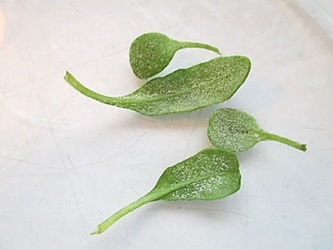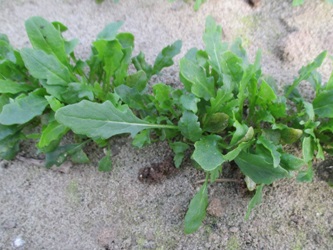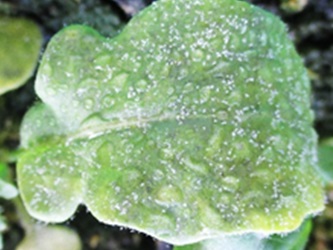 |
 |
 |
 |
Downy mildew in rocket
Rocket downy mildew, caused by the oomycete Hyaloperonospora sp., is an epidemic disease that remains a serious problem for rocket growers, once crops quickly become compromised with very weak yields and poor quality. Growers in different regions of the world reported significant losses due to the downy mildew disease in Diplotaxis tenuifolia (wild rocket), while the Eruca sativa (cultivated rocket) is mentioned as more resistant.
The introduction of new pathogens and the intensification of existing problems in rocket production have arisen in the last years, as a consequence of the dynamism of the sector, massive diffusion of rocket species cultivation, specialization and use of intensive cultivation techniques. During the last two decades, the planted area has rapidly expanded and 12-month production cycles are common in the main production areas, accompanied by high-density plantings and reduced use of crop rotation, originating a higher occurrence of diseases and pests.
Cool and high air humidity conditions are favourable to downy mildew development. The high susceptibility of the varieties and the easy airborne dispersion of spores in crops cultivated in open field and greenhouses, associated with the short periods of leaf surface wetness to achieve infection contributed to a large increase of downy mildew disease incidence and severity in rocket production.
Fungicides are the primary tool for controlling diseases like downy mildew, but the use of foliar chemicals on the rocket production is problematic. The very short interval between subsequent harvests and the need to perform foliar fungicide application prior the disease onset limit the pesticides use. At present, few products are available for organic rocket production, and the great risk in developing more virulent pathotypes resistant to fungicides is a concern.
Pathogen taxonomy
The delimitation of species is a notoriously difficult taxonomic problem, particularly evident in the obligate biotrophic oomycetes which are fully dependent on living host cells for their nutrition. The definition of species for plant pathogens has a considerable practical impact on plant protection measures or biological control, and is also important in comparative studies involving model organisms.
The oomycetes are a large group of organisms that cause serious foliar diseases like the downy mildews. Although they superficially resemble fungi in mycelial growth and mode of nutrition, molecular studies and distinct morphological characteristics place them in the kingdom Chromalveolata (phylum: Heterokontophyta, class: Oomycetes, order: Peronosporales, family: Peronosporaceae).
Several main changes occurred in concepts of the oomycete species in the family Peronosporaceae and the taxonomy of the causal agent of downy mildew on different Brassica crops continues to be debated. In recent years, much effort has been devoted to elucidate the genetics and biochemistry of particular oomycetes due to their impact. It is the case of the causal agent of downy mildew disease in the wild rocket (Diplotaxis tenuifolia) and the cultivated rocket (Eruca sativa) classified as Hyaloperonospora sp.
The genus Hyaloperonospora contains more than 100 species that can infect economically important crops of the Brassicaceae family. At 2018, Choi and collaborators classified the causal agent of downy mildew disease on Eruca sativa by Hyaloperonospora erucae sp. nov., suggesting the distinctiveness of this species from that infects the wild rocket (Diplotaxis tenuifolia), which is still known as Hyaloperonospora sp.
Downy mildew symptoms
Typical symptoms of downy mildew disease can be clearly observed on rocket infected plants. During periods of high air humidity and especially when the leaf tissues are wet, conidiophores (fruiting structures) with conidia, whitish, dense, and felt-alike on infected down leaf tissues. When plants are very susceptible and under favourable climatic conditions, both sides of the leaf are affected and the infection may extend to stems and petioles. Later, the occurrence of conidiophores is accompanied by dark or yellowish lesions, and rot in the case of high infestations. Heavily infected plants are unmarketable and have to be abandoned before harvest. Downy mildew destroys the quality of the leaves and causes production losses. Usually, the occurrence of areas of sporulation decreased over time, and the younger seedlings were more affected by downy mildew disease.
If air conditions are dry, the sporutated lesions can desiccate and turn white or tan. In this case downy mildew infection can be difficult to observe, and the signs can appear later when the product is on the market shelves. In fact, the pathogen develops at low temperatures that prolong the incubation period, usually up to 12 days.
Pathogen life cycle
The infection on leaves occurs from airborne conidia. The pathogen infects about six hours after landing on a plant surface. The conidia of Hyaloperonospora germinate on a leaf, only by means of a germ tube, and penetrates the plant tissue directly through the anticlinal walls of the epidermal cells via appressorium. After penetration, the induced hyphae forms mycelium and their specialized forms, the haustoria. Inside the tissues, the haustoria are globose to lobate and fill the host cell partly to almost completely to obtain the nutrients. The oomycete hyphae and haustoria grow until they have penetrated almost the entire leaf, eventually causing visible necrotic lesions in leaves of the resistant varieties.
Finally, often formed at night when the air humidity is highest, tree-alike conidiophores emerge from stomata, in a fascicle, hyaline, straight and monopodially branched in 7-9 orders. Ultimate branchlets are mostly in pairs, flexuous to curved, and had obtuse or subtruncate tips. Hyaline conidia are broadly ellipsoidal to subglobose, and measure 20-28 µm long and 15-25 µm wide.
Downy mildew disease cycle
Downy mildew is a polycyclic disease and the main infection on leaves occurs from the airborne conidia dispersed by wind, rain and splashed irrigation water. The disease is more severe during mild, but also fresh seasons, usually in early spring or late fall, under high air humidity conditions. Cool temperature (12-15⁰C) and moist conditions (relative humidity of 90-98%) favour the disease development. The asexual cycle can be completed in 3-4 days at 20°C and moist conditions.
Hyaloperonospora sp. can survive as oospores in infected plant debris in the soil, and these are probably the primary source of inoculum and may lead to a systemic infection of the roots in following cultivation. During the sexual stage, the pathogen forms oogonia and antheridium, that result in spherical, yellow-brown and thick wall oospores.
Host specificity
The Hyaloperonospora oomycete infects several plant species of the Brassicaceae family. However, the isolates from the different Brassica species are usually more virulent on the species of the origin. Most Hyaloperonospora species are morphologically uniform, but they exhibit considerable diversity with respect to genetic distances and host plants.
The isolates of Hyaloperonospora sp. from the wild rocket (D. tenuifolia) infect only seedlings of this species. There is no cross-infection between isolates harvested from wild rocket and other Brassica species (e.g., cultivated rocket, broccoli, cauliflower, swede, oilseed rape). Also, wild rocket and cultivated rocket plants are not infected with isolates from other Brassicas, such as swede, broccoli and cruciferous weeds (Capsula bursa pastoris and Thlaspi arvense).
The use of molecular phylogenetic analysis and the variation in the hosts have shown a narrow species delimitation within the family Peronosporaceae, and it is a reliable means to discriminate downy mildew species for which morphological differences are unknown. The specificity pattern of the Hyaloperonospora isolates to different hosts of the family Brassicaceae shows that the variation of the host can discriminate the different species of the pathogen and can be used as a taxonomic marker in the downy mildew of Brassica.
Measures to control downy mildew disease
Crop rotation, removal of plant residues from soil, and weed control are useful preventive practices for downy mildew control. Other practices include the use of certified seeds, adequate irrigation systems, and air circulation to reduce air humidity. There are some fungicides available for management of rocket in conventional production; however, under the organic farming system this use is more difficult because the synthetic fungicides are prohibited.
The intensive rocket production and the cultivation of a reduced number of cultivars of the same species can induce rapid changes in the parasite populations and decrease of the plant resistance. The use of resistant plant varieties reduces the incidence of disease infection and is the most economical and environmental-friendly means of managing the downy mildew, in conventional and organic rocket production. Partially forms of plant resistance do not entirely prevent the onset of the disease but delay its progression and can be effective when combined with adequate agricultural practices. The delay in the disease progression observed on partially resistant sources would result in less leaves depreciation and may keep the disease development under the critical economic level. Intermediate resistance response is usually more durable and effective against different pathotypes.



